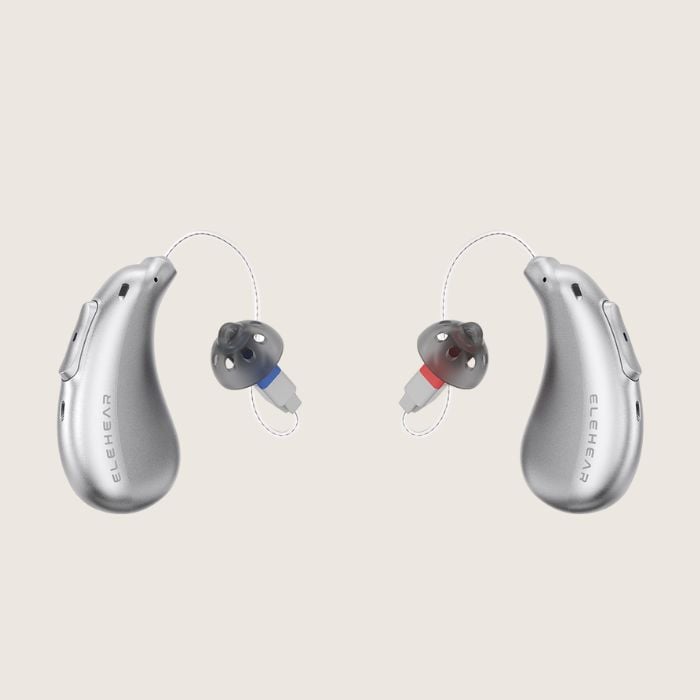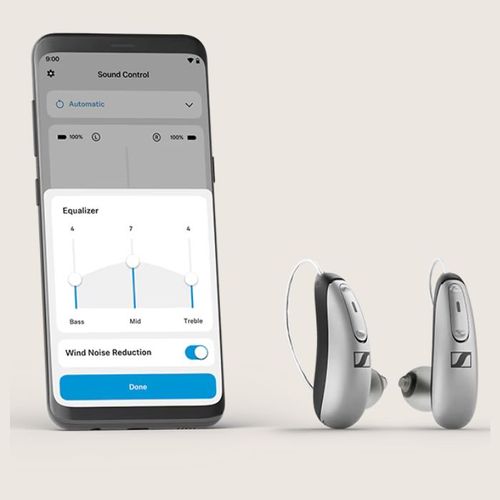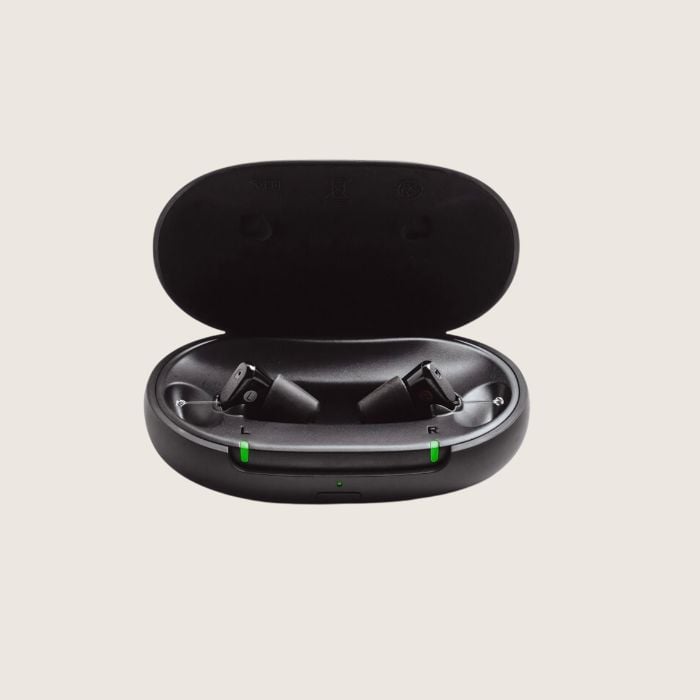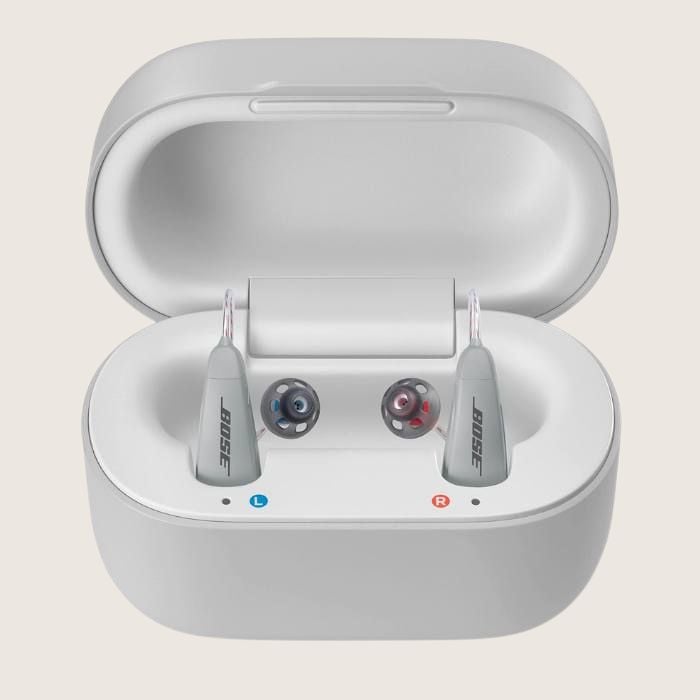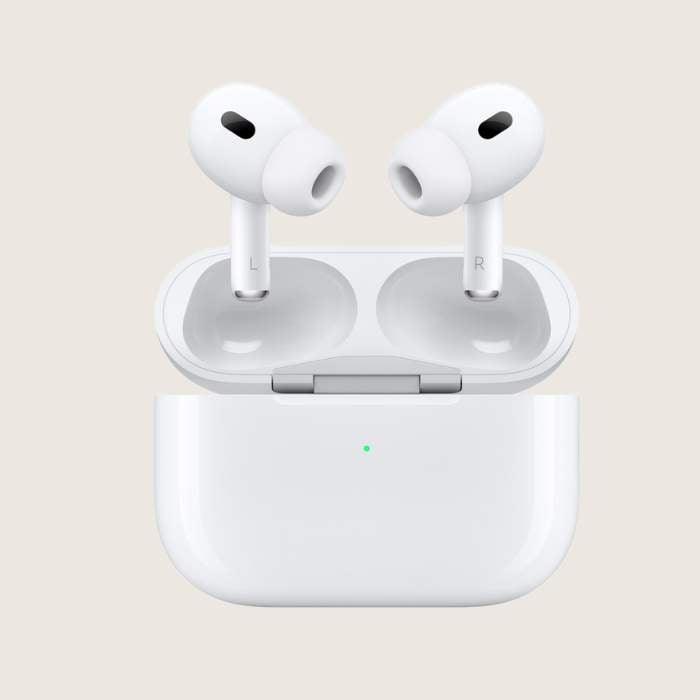Over the past year, we’ve tested and reviewed over 50 hearing aids across every price point. In this guide, we’ll narrow our focus to the products that deliver exceptional value for their price.
Hearing aids range in price from $99 to $7,000 per pair. With such a wide price range, many people wonder: what are the best affordable hearing aids that still deliver quality?
Because everyone’s definition of “affordable” is different, we’ve included hearing aids priced from $399 - $1,000 per pair. We evaluated several products under $399 but found they didn’t meet the criteria for this guide (see the full list of brands considered below).
To make things easier, we’ve organized the guide by price point—so as you scroll, you’ll see options at the lower end of the spectrum first, followed by slightly more expensive choices.
Let’s dive in.
Prefer to watch?
See our video breakdown of the best affordable hearing aids for 2025. 👇
- Price Range of Hearing Aids: Hearing aids vary significantly in price, ranging from as low as $99 per pair to as high as $7,000 per pair.
- Top Affordable Hearing Aid Under $500: The Elehear Beyond, priced at $399 per pair, stands out for its features, including a robust app for adjustments, rechargeable batteries, Bluetooth streaming, and tinnitus masking.
- Best Mid-Range OTC Hearing Aids: The Sennheiser All Day Clear, at $999 per pair, offers premium sound quality, comfortable design, and an intuitive smartphone app for easy setup and self-programming.
- Starter Hearing Aid Option: Apple's AirPods Pro 2, priced at $249.95, have introduced features that can assist with hearing, providing an accessible option for those with mild to moderate hearing loss
- 50+ hearing aid brands reviewed and rated by our team of hearing aid wearers and audiologists
- 200+ hours each month spent researching brands and care options
- 2,000,000 people shopped on Soundly in 2024
- 100% independently owned and operated
Read more about our company, services and process here.
Featured in this article
Best Hearing Aids Under $500 - Elehear Beyond
After testing dozens of products from Amazon and big box stores—many from unfamiliar or overseas brands—we found most fell short in performance and reliability. Thankfully, one product stood out: Elehear Beyond.
At $399 for a pair, Elehear Beyond offers impressive features like a robust app for adjustments, rechargeable batteries, Bluetooth streaming, and even tinnitus masking—a feature usually found in pricier models. When purchased through Soundly, you’ll also receive a complimentary setup call with an audiologist, adding even more value.
With its solid features and Soundly’s support, Elehear Beyond is our clear favorite for sub $500 hearing aids in 2025.
Elehear Beyond
- Our favorite OTC hearing aids for under $500
- Compatible with iPhone and Android devices
- Bluetooth streaming and rechargeable
Here’s why we picked Elehear Beyond:
- Sound Clarity: Elehear Beyond’s noise reduction effectively separates speech from background sounds, providing clear listening in a variety of environments.
- Simple Bluetooth Streaming: Elehear Beyond connects directly through Bluetooth settings, similar to pairing regular headphones. It supports music and calls without requiring extra accessibility setup steps.
- Battery Life: The charging case provides up to 20 hours of use after a 90-minute charge, making it convenient for all-day wear without needing frequent recharges.
- Customizable Sound Settings: Through the Elehear app, users can adjust bass, treble, and volume to match their personal preferences, offering more control than pre-set options in higher-end models.
- Affordable Choice: Priced at $399 per pair, Elehear Beyond is an accessible option in the OTC market, with essential features suited for those who prefer handling adjustments independently.
- "These are amazing for the price! I bought them as a backup to my expensive prescription ones and I use them more often than the originals. The price is amazing for what you get. One suggestion is that there should be sport guards for them to protect from loss"
- "Good hearing aids for the price. They’re effective, but I’ve had some minor issues with background noise in crowded areas. Nothing major, but something to note"
- "I've had the Beyond hearing aids for a few weeks now. They work well, but I’m still getting used to adjusting the settings. Overall, a solid product, but a bit of a learning curve."
- "Thanks to customer support.My hearing aids arrived damaged, customer support was able to replace it in just one day"
- "Comfortable for All-Day WearI can wear these all day without any discomfort. They’re light and fit snugly in my ears. A great fit for daily use."
- "I can hear much better with theseI can hear much better with these, but they sometimes feel a little loose after wearing them for a few hours. Other than that, I’m happy with the sound quality."
- "Finally I can listen to musicI love bluetooth feature, listening my favorite songs directly to my hearing aids feels amazing!!!"
- Robust features for a very affordable price
- Bluetooth streaming (iPhone and Android)
- Tinnitus masking features
- Requires some tech savvy
- Newer company
- Slightly less advanced sound (although impressive for the price)
- Elehear Beyond is an OTC product appropriate for mild-moderate hearing loss levels
- If you have more significant hearing loss you might consider local or Telehealth care. Read more about prescription Vs. OTC hearing aids here
- Available for purchase online or at retail stores
- Does not require a prescription from a doctor
- Customize your hearing aids through dials and controls inside a smartphone app
- Elehear Beyond has the best sound quality we've seen at products under $500
- Comfortable receiver-in-canal style is great for all day wear
- Sits behind the ear with a receiver (speaker) that reaches into the ear canal
- The form factor of Elehear Beyond is comparable to leading prescription hearing aids
- Only available in silver
- Elehear Beyond comes with rechargeable batteries and a portable recharge case
- 20 hours of wear on a single charge
- New recharge case carries an additional 80 hours of portable charge (without being plugged in)
- Elehear Beyond is compatible with iPhone and Android Devices
- Bluetooth connection is managed through the settings app
- Elehear Beyond is reasonably easy to handle but does require the wearer to place the hearing aid behind their ear and insert the receiver into the ear (consistent across all behind-the-ear styles)
- Elehear Beyond has an IPX5 raing
- In practical terms, an IPX5-rated device can handle splashes, rain, and some exposure to water but is not fully waterproof
- Adjust volume, sound quality and background noise
- Elehear Beyond comes with built-in tinnitus management features
Best Hearing Aids Under $1,000 - Sennheiser, Sony, Lexie
If you have a bit more room in your budget, consider hearing aids from a few leading brands in the $800-$1,000 price range. Sennheiser, Sony, and Bose all are made by trusted manufacturers and offer excellent smartphone apps and audiology-grade sound quality.
At the moment, Sennheiser and Sony are our two best-selling products, and for good reason—they deliver outstanding value for money. When you compare their features to similar products sold in clinics, you’ll notice many of the same advanced capabilities.
Sennheiser All Day Clear
- Our favorite OTC hearing aids for under $1,000
- Manufactured by the largest hearing aid maker in the world
- Compatible with iPhone and Android devices
Here’s why we picked the Sennheiser All-Day Clear:
- Trusted Manufacturer: Developed by Sennheiser, a leader in audio, and backed by Sonova, the world's #1 hearing aid maker, ensuring high-quality sound and technology.
- Comfortable Design: Lightweight and comfortable for all-day wear, available in both Slim and standard models to suit different preferences.
- Affordable Price: Offers premium sound quality and features typically found in prescription hearing aids, all for under $1,000.
- Easy App Control: The intuitive smartphone app allows for quick, user-friendly setup and self-programming, ideal for even mildly tech-savvy users.
Sennheiser All Day Clear reviews are about as glowing as you'll find among self-fit devices. Users comment on Sennheiser's lightweight comfort, clear sound and easy to use app. Some users wished that the battery life was longer for 16+ hours of wear. Here are some sample reviews:
- "One of the best over-the-counter hearing aids you'll find.They're extremely lightweight which I really appreciate because usually whenever I use any sort of earbuds I like it to wear I don't even feel like they're on my ear.The clarity of the audio that comes out of these small little hearing aids is very impressive." - Jay
- "The instructions are not complicated and the all day clear app for the phone is easy to use and works well for personal customization. You can use the hearing aids itself to control the volume and connect to other devices. The all day clear hearing aids are comfortable to wear all day. I feel more confident because I feel like I am apart of conversations and not alienated in life. The battery life is good but you will need to recharge if you are wearing them all day." - Kamille
- "I got my 72-year-old dad the Sennheiser hearing aid, and oh boy, it's a total game-changer! Dad's been dealing with some hearing trouble for a while, but this device has turned things around big time.Being far away from him, I sent the aid his way, and he managed to set it up all by himself using YouTube. Easy peasy! Now, he's raving about how it's like night and day. In group chats, he used to miss out on voices, but not anymore. He's hearing everyone loud and clear, even when Mom calls him from another room." - Britto
- Premium Sonova-built technology for less than prescription channels
- Bluetooth streaming and hands-free calls (Android and iPhone)
- Comfortable all-day form factor
- Charger must be plugged in while charging
- Requires a smartphone for programming
- All-Day Clear is an OTC product appropriate for mild-moderate hearing loss levels
- If you have more significant hearing loss you might consider local or Telehealth care. Read more about prescription Vs. OTC hearing aids here
- Available for purchase online via Soundly
- Does not require a prescription from a doctor
- Customize your hearing aids with the Sennheiser All-Day Clear app
- Soundly customers get a complimentary guided setup session
- Sennheiser offers impressive underlying background noise management technology
- We found this product performed at a similar level to top prescription brands
- Comfortable receiver-in-canal style is great for all day wear
- Sits behind the ear with a receiver (speaker) that reaches into the ear canal
- The form factor of Sennheiser All-Day Clear is comparable to leading prescription hearing aids like Phonak Lumity
- Available in a dual-tone black and silver
- Choose between slim and non-slim versions (we recommend the non-slim option for most people)
- Sennheiser All-Day Clear comes with rechargeable batteries
- 16 hours of wear on a single charge
- Recharge case must be plugged into the wall while in use
- All-Day Clear streams to all devices including iPhone and Android
- All Day Clear allows hands free phone calls on both iPhone and Android
- Streaming quality is similar to the top prescription products on the market
- All-Day Clear is reasonably easy to handle but does require the wearer to place the hearing aid behind their ear and insert the receiver into the ear (consistent across all behind-the-ear styles)
- The All-Day Clear recharge case has ports that must be in contact for charging. This type of charger is more difficult than premium conduction chargers which do not require ports to be touching
- Sennheiser All-Day Clear hearing aids have an IP68 rating
- These devices can be submerged in up to one meter of water for 30 minutes without damage
- The Sennheiser All-Day Clear app enables setup and customization of your hearing aids
- The smartphone app allows on-the-go volume and sound quality adjustments
- The All-Day Clear app has a music and automatic program but does not offer Tinnitus masking, program creation or other advanced features
Sony CRE-C20
- Soundly's top-selling in-ear OTC hearing aid
- Nearly invisible in most ears
- 28-hour battery life per charge
- Self-fits through Sony's smartphone app
Sony’s CRE-C20 is a big step up for in-ear OTC hearing aids, packing new features that make it our top pick. Here’s why we chose it:
- Sound Quality Boost: Sony borrowed tech from in-clinic product Signia Silk for sound processing, and the difference is clear. The CRE-C20 delivers noticeably better sound than past models.
- Long-Lasting Battery: With 28 hours on a single charge, you can count on the CRE-C20 to get you through a full day.
- Invisible, Comfortable Fit: Designed to be invisible in most ears, the CRE-C20 fits comfortably and stays discreet—even more so than many other IIC models we’ve reviewed. We especially like the slightly curved design that improves in-ear comfort.
If you’re looking for an in-ear OTC hearing aid, the CRE-C20 wins on sound, battery, and comfort.
Sony CRE-C20 is Soundly's top-performing in-ear OTC hearing aid. Our customers love the discretion and sound quality and often comment on how comfortable CRE-C20 is compared to other in-ear options. Some customers do report that the app setup is more involved than simpler products like Lexie or Sennheiser. Some sample review:
- "Over the past few years, I have tried a half-dozen or more OTC hearing aids and none of them were better than the Sony CRE-C20 aids that I have had the opportunity to evaluate. I have tried less costly and more expensive OTC's - doesn't matter - these were the answer to my inability to hear in many situations." - Ern
- "In terms of function, I was very impressed with the overall sound quality once it was dialed in. Initially they sounded a bit tinny, but that was easily adjusted with the Sound Balance control. It took a couple of days of use and adjusting before I really felt they were dialed in. At that point I wore them all day in different environments to put them through their paces. One of my main concerns is the ability to hear clearly and understand what the person I’m speaking with is saying in a louder environment. The CRE-20Es did a fantastic job with toning out the background noise and producing a clear and easy to understand conversation experience. I tend to have to listen and read lips at the same time but quickly realized I could hear the conversation very well, even in a loud restaurant environment." - Stanley
- "These are IP68 Sweat and water resistant - I was able to wear these biking multiple times without any fear of them falling out or being damaged." - James
- "I shut down and restarted the app, turned off my phone, uninstalled and reinstalled the app, and nothing seemed to work. I tried the next day, and then it worked." - Trobadaur
- C20 is Nearly invisible in most ear canals
- High quality sound for a lower price
- Self-fit at home
- Rechargeable with 28 hours of battery life
- Does not allow Bluetooth streaming
- Requires some tech-savvy for setup
- Only for mild-moderate hearing loss
- Sony CRE-C20 hearing aids are sold over the counter and are appropriate for those with mild-moderate hearing loss
- If you have more significant hearing loss it is recommended that you access professional care through Telehealth or local care
- Available for purchase here Soundly.com with a complimentary guide setup service
- Does not require a prescription from a doctor
- Customize your hearing aids with an onboard hearing test and app-controls
- Sony CRE-C20 is made in collaboration with hearing leader WSA audiology
- Sony CRE-C20 offers good background noise management algorithms and newly re-designed processing chip
- Sony CRE-C20 sits discreetly in the ear and comes with various ear tip sizes
- Sony CRE-C20 is not custom-molded to your ear shape
- Our team finds all in-the-ear models slightly less comfortable for all-day wear than RIC hearing aids
- Sits inside the ear
- Only available in one completely-in-canal size (invisible in many ears)
- Only available in black
- Sony CRE-C20 has rechargeable batteries
- Sony CRE-C20 batteries last 28 hours on a single charge
- The included CRE-C20 carry-case comes with three additional on-the go charges
- Sony CRE-C20 does not come with Bluetooth streaming
- Sony CRE-C20 is a small device which can pose dexterity challenges
- Sony CRE-C20 uses rechargeable batteries and has a convenient charge case with strong magnets that pull the devices into place
- CRE-C20 is water resistant but we recommend you avoid water activities while wearing (i.e. swimming)
- Sony CRE-C20 uses a smartphone app which includes an onboard hearing test and manual controls for bass, treble and volume
- The app is required to make changes (no buttons onboard)
Lexie B2+ Powered By Bose
- Self-fit with the Lexie app, adjusting treble, bass, and directionality.
- Rechargeable with 18-hour wear time and an on-the-go charging case.
- Bluetooth streaming for calls on both iOS and Android.
- On-demand support from Lexie hearing experts for setup and care.
Lexie leads the OTC hearing market in volume, with wide availability in pharmacies and strategic partnerships that make it highly accessible. Here’s why it stands out:
- User-Friendly App with Extensive Adjustments: Lexie’s app offers near-limitless adjustment options, ideal for users who want full control over their sound quality.
- Top-Notch Customer Service: Lexie excels in customer support, allowing users to connect quickly through the app for any assistance needed.
- Soundly Extras: Purchasing Lexie hearing aids through Soundly includes a complimentary audiology setup call, ensuring you start with a perfectly tailored fit.
Ease of Use and Setup
- Cindy B. – "After a lot of research on OTC hearing aids for my moderate hearing loss, I chose Lexie B2 Plus. I wanted rechargeable hearing aids that would link to my iPhone, and the price was affordable...One of the most exciting experiences I’ve had was hearing the birds in my backyard! It was almost completely quiet without them on."
- William – "These Lexie B-2's were easy to adjust per the app and proved to be superior to the more expensive ones, plus no trips to the doctor every week or so."
Sound Quality and Listening Experience
- Faith Li – "The Lexie B2 hearing aid doesn't get time to charge as I just love wearing them. I am grateful for the gift of hearing and that I no longer miss out on the moments."
- Listener T. – "The sound quality through the aids was fine, once I had them set appropriately. The noisy room filter allowed me to focus on the person in front of me in a restaurant."
Affordability and Value
- Carolyn – "I kept putting off getting hearing aids because they are so expensive and my insurance doesn’t cover them. Once the audiologist mentioned the high quality, I looked into them...What a difference they have made!"
- Kyle, MD – "The Lexie B2 Plus hearing aids are very good introductory hearing aids...The sound quality is excellent and extremely natural."
Challenges
- DJR-NJ – "Customer service and support were excellent! Unfortunately, I was unable to wear the devices because the wires were too short. They did respond quickly to my calls and sent the longest wires they make, but I still couldn't wear them long enough to judge their performance."
- James - "Android App on my phone kept dropping connection with the Lexie hearing aids. The app was more consistent on my iPad"
- Shopper A - "Android phone tries to play audio through hearing aids with No Way To Turn it off unless it's a phone call. Otherwise, you must turn your media volume off. Phone call through hearing aids mutes your microphone so caller can't hear you."
- Strong underlying technology
- Self-fitting using the Lexie app
- Affordable and rechargeable
- Only comes in one color
- Not for those with severe hearing loss
- Lexie B2 Plus - Powered by Bose is an OTC product appropriate for mild-moderate hearing loss levels
- If you have more significant hearing loss you might consider local or Telehealth care. Read more about prescription Vs. OTC hearing aids here
- Available for purchase online or at retail stores like Walgreens and Best Buy
- Does not require a prescription from a doctor
- Customize your hearing aids with an onboard hearing test and app-controls
- Lexie B2 Plus Powered by Bose is among our top-rated OTC hearing aids for overall value
- Technology from Bose does a great job managing background noise
- Comfortable receiver-in-canal style is great for all day wear
- Sits behind the ear with a receiver (speaker) that reaches into the ear canal
- The form factor of Lexie B2 Plus Powered By Bose is comparable to leading prescription hearing aids
- Only available in grey
- Lexie B2 Plus Powered by Bose comes with rechargeable batteries and a portable recharge case
- 18 hours of wear on a single charge
- New recharge case carries an additional 18 hours of portable charge (without being plugged in)
- Lexie B2 Plus Powered by Bose added Bluetooth streaming for iPhones in 2023 and now with compatible Android™ devices
- Refer to the FAQs at LexieHearing.com to check if your Android™ device is compatible.
- Lexie B2 Plus Powered by Bose uses Apple's MFi protocol for connection
- Streaming functionality is designed for phone calls. While music and media streaming is possible, it is not optimal.
- Lexie B2 Plus Powered by Bose is reasonably easy to handle but does require the wearer to place the hearing aid behind their ear and insert the receiver into the ear (consistent across all behind-the-ear styles)
- Lexie B2 Plus Less waterproof than industry leaders but still sweat and moisture resistant
- Take an onboard hearing test to customize your hearing aids
- Adjust directionality between “Everywhere” and “Front” modes so you can choose between hearing sounds around you or the sound that’s in front of you
- Manually customize treble/bass, volume and programs
Best Hybrid Hearing Aid - Apple AirPods Pro 2
If you’re looking for a starter hearing aid, Apple’s AirPods Pro 2 are worth considering. In late 2024, Apple released a software update that effectively transformed the AirPods Pro 2 into a pair of OTC hearing aids. Priced at just $249 per pair and packed with the robust features you’d expect from an Apple device, the AirPods Pro 2 offer exceptional value.
While they aren’t designed to replace a traditional hearing aid for all-day use—mainly due to their form factor and battery life—they’re a great, affordable option for someone just beginning their hearing health journey. With a seamless setup and decent sound quality, they provide a solid entry point into the world of hearing assistance.
Apple AirPods Pro 2
- Earbuds and hearing aids in one
- Onboard hearing test via iPhone
- Quality sound in quiet environments
AirPods Pro 2 aren’t just for music anymore—they’re now an FDA-cleared hearing aid alternative built right into Apple’s ecosystem. For users with mild-to-moderate hearing loss, this device offers:
- Built-In Hearing Test: Apple’s custom hearing feature uses a short test to tailor amplification to your needs—no audiologist required.
- Dynamic Sound Enhancement: Speech sounds are emphasized while background noise is reduced, especially in quiet or moderate environments.
- All-in-One Convenience: For iPhone users, AirPods Pro 2 combine assistive listening, media streaming, phone calls, and noise management in one device.
- Many users report meaningful improvements in speech clarity during conversations, especially in quiet settings.
- The onboard amplification is simple to set up and at least somewhat effective for mild hearing loss.
- Users appreciate the seamless experience, with automatic adjustments based on environment and hearing profile.
- Performance is best in quieter spaces—some users note challenges in loud, group environments.
- Built-in hearing test with personalized amplification
- Seamless experience for iPhone users
- Offers hearing aid functionality without a prescription
- Great for phone calls and music
- Less effective in very noisy environments
- Requires some explaination when worn in social settings
- May not be comfortable for all-day wear for every user
Side-by-side comparison of affordable hearing aid options. 👇
What Drives Hearing Aid Prices?
Why are hearing aids so much pricier than other consumer tech? After all, you can pick up a pair of headphones for $30 or $40—why not hearing aids? The answer boils down to two key factors: service costs and research and development.
Service
The biggest driver of high prices for prescription hearing aids is the cost of in-person care. When you purchase hearing aids through a clinic, you’re not just paying for the devices—you’re covering the costs of the audiologist’s time, the front desk staff, the clinic’s rent, electricity, and other overhead expenses. These costs add up, driving the average price of prescription hearing aids to around $4,500 per pair.
Here's a breakdown of typical hearing aid prices by care model:
- Lesser-known OTC brands: $100–$500 per pair.
- Brand-name OTC hearing aids (e.g., Sony, Sennheiser): $800–$1,000 per pair.
- Prescription hearing aids (purchased through a local clinic): $3,500–$7,000 per pair.
R&D Costs
The second factor is R&D. Hearing aid manufacturers invest millions each year to develop new technology that makes sound more natural and reduces background noise. This ongoing innovation ensures high-quality hearing aids but also raises costs. While there’s plenty of healthy debate about manufacturer margins, the fact remains: top-tier hearing technology costs more than simpler products like headphones or even cell phones.
Thankfully, for those with mild to moderate hearing loss, the new over-the-counter (OTC) model provides a more affordable option. Products like the Elehear Beyond offer specialized features at consumer-tech-level pricing, making quality hearing care more accessible than ever.
OTC vs. Prescription Hearing Aids: What’s the Difference?
According to our research, the average prescription pair of hearing aids costs around $4,500. Unfortunately, most insurance plans do not cover hearing aids and when they do they typically offer a "discount" instead of a cash benefit. That means those seeking in-person care at a local clinic should be prepared to spend at least $2,500 on their hearing care.
This is where OTC hearing aids come in. OTC devices, which officially became available in late 2022, offer audiology-grade technology at a much lower price. However, they are only suitable for people with mild to moderate hearing loss. If you’re unsure about your hearing level, you can take our hearing test to get a better idea and watch the video below to understand your results.
What if I need prescription care?
If you have severe or profound hearing loss, prescription hearing aids might be necessary. Here are three options to make the process more affordable:
- Check your insurance benefits – Contact your provider to see what coverage is available for hearing aids.
- Use a discount group like ZipHearing – They offer lower prices compared to walking into a clinic off the street.
- Visit a big box retailer like Costco – Costco offers high-quality hearing aids at competitive prices. You can read our detailed review of Costco hearing aids here.
For those with mild to moderate hearing loss, OTC hearing aids are almost always the most affordable option available.
Free or Low-Cost Hearing Aid Options
There are several free or low-cost options worth exploring:
- Non-Profit Organizations: Groups like the Hearing Loss Association of America or Lions Club International offer programs to help those in need.
- Government Programs: Medicaid and other state programs may provide coverage for hearing aids.
- Veteran Benefits: Veterans may qualify for hearing aids through the VA.
- Clinical Trials: Participating in clinical trials can sometimes provide access to free hearing aids.
CaptionCall No-Cost Phone Service
For anyone with hearing loss, CaptionCall offers free captioning services for phone calls and provides an amplified phone at no cost. They’ll even bring it to your home and set it up at no cost. Clearly a caption phone is not the same as a pair of hearing aids, but the service can provide some much needed relief. These services are funded by the FCC and require no payment from users.
What to Avoid When Shopping For Affordable Hearing Aids
Every option on this list meets our standards, but here are a few tips to guide your broader search and prevent hearing aid shopping pitfalls.
- Start with a hearing test – Before buying, take a hearing test to understand your level of hearing loss. Whether you use Soundly’s test or get tested locally, it’s important to know if you have mild to moderate hearing loss (ideal for OTC options) or severe to profound loss (which may require prescription care).
- Purchase from a reputable retailer – Buy hearing aids from trusted retailers or directly from well-known brands. We recommend avoiding mass-market platforms like Amazon, where product vetting is minimal, and brands are only required to list their products. If a brand isn’t widely mentioned online or in trusted resources, it’s best to steer clear for now.
- Avoid secondhand purchases – While secondhand options on platforms like eBay may seem tempting, they often come with risks such as voided warranties or questionable origins. It’s best to purchase new hearing aids from verified sources.
If you’re unsure where to start, reach out to us at [email protected] or text/call us at 1-213-460-1310. We’re happy to review your hearing test and help you explore the best options for your needs.
Final Thoughts
If you’ve made it this far, you now have a solid understanding of what drives hearing aid prices, the options available on the market, and how your unique hearing needs play a role in finding the right product.
The good news? It’s an exciting time for hearing aid wearers seeking affordable solutions. Just a few years ago, many of the options on this list simply didn’t exist. Today, you can access audiology-grade sound at a fraction of the cost you would have paid in 2020.
That said, the market can still feel overwhelming. If you have questions or need support, don’t hesitate to reach out to us. We’re here to help guide you every step of the way. Thank you for reading, and we hope this guide has made your journey a little clearer.
Frequently asked questions
Some insurance policies cover hearing tests, but the majority of policies do not cover hearing aid devices. It's a good idea to call your insurance company to double-check on this. Read our full guide on the topic here.
Original Medicare does not cover hearing aid costs. It does cover hearing tests in many cases. One option is to get a covered hearing test locally and use it to find a good option online for less. Some Medicare Advantage plans do cover hearing aids. Read our full guide on Medicare and hearing aids.
If you have served in the U.S. military, there is a good chance the VA could cover your hearing aids and hearing care.
Process Overview:
- Apply for VA benefits.
- Schedule an appointment.
- Meet with a VA audiologist.
- Schedule an appointment to be fit with hearing aids.
Here's a full breakdown of the VA hearing aid application process.
Absolutely. Hearing aids are transformational in many social settings, and research indicates they improve connection, overall health, and earning potential. Around 80% of hearing aid wearers across budget levels are happy they made the purchase.
The short answer is, yes, hearing aids qualify for a tax deduction. However, the answer in your specific situation will depend on a few factors:
- Did your out-of-pocket medical care expense exceed 7.5% of your adjusted gross income?
- Did you pay for your hearing aids through a health savings account (HSA)?
- Do you qualify for the Earned Income Tax Credit (EITC) or the disability tax credit?
Read our full guide to taxes and hearing aids.
The stated goal of new OTC hearing aid legislation was to bring down hearing aid prices. In reality, it appears that OTC devices will create a new robust (and quality) budget option, but traditional prescription models will stay at roughly the same prices due to their hands-on service.
Conventional wisdom is that prices for both OTC and prescription devices will remain roughly the same for the next few years.
Getting hearing aids on a fixed income can be challenging. While there aren't any government programs that make hearing aids free for seniors (hopefully someday!) There are many local organizations around the United States that can provide financial support for hearing aids.
These range from hearing providers to local Lions Clubs and nonprofits. The Hearing Aid Project has an excellent resource for finding these programs here. The Hearing Aid Project also accepts hearing aid donations.
The Hearing Loss Association of America has a list of published resources along with a PDF guide here.
Don't give up too fast. You've got options. If OTC hearing aids aren't within your budget or don't meet your needs, you might be a candidate for non-profit financial assistance.
The Hearing Aid Project has an excellent resource for finding these programs here. The Hearing Aid Project also accepts hearing aid donations.
The Hearing Loss Association of America has a list of published resources along with a PDF guide here.
This is an important (and slightly complex) topic. Most prescription hearing aids come in a few different technology levels. The "economy option" typically has fewer bells and whistles, and the premium option has more. In general, "economy options" are still very credible and achieve significant benefits. Read our full guide to technology levels here.




